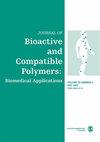Fabrication, characterization, and in vivo implantation of eugenol-loaded nanogels and PCL/Cs electrospun nanofibers for wound healing applications
IF 2.1
4区 生物学
Q3 BIOTECHNOLOGY & APPLIED MICROBIOLOGY
引用次数: 0
Abstract
Developing wound dressings with a high potential to cover damaged skin tissue and facilitate cell adhesion and migration at the injury site is crucial in skin tissue engineering to accelerate wound healing. Electrospun nanofibers from natural/synthetic polymers are amongst the favorable wound dressings with appropriate physicochemical and biological properties. As well, nanoformulations of phenolic phytochemical “eugenol” have been shown to fasten wound healing via various anti-inflammatory and anti-oxidant effects. Herein, we developed a bi-component wound dressing of PCL/Cs electrospun nanofibers and eugenol nanogel to investigate its effects on tissue healing in vivo. PCL/Cs nanofibers were fabricated using an electrospinning method at the 15:1 ratio, and eugenol-loaded nanogels were synthesized by adding carboxymethylcellulose as the gelling agent, and their physicochemical characteristics were assessed. Scaffolds were implanted in a full-thickness excision wound model in Wistar rats, followed up for 21 days. The results showed that electrospun nanofibers had an average diameter of 228 nm with uniform and smooth morphology aligned randomly. Eugenol-loaded nanogel showed an average size distribution of 126 nm. Eugenol-loaded nanogel and nanogel + nanofiber groups significantly reduced wound surface area over 21 days. Histological evaluations showed that Eugenol-loaded nanogel and nanogel + nanofiber groups developed the full-thickness epidermis with the complete epithelium and stratum corneum, angiogenesis, and low macrophage infiltration in which predominantly mature collagen fibers were poorly and well organized, respectively. The combination of eugenol-loaded nanogel + PCL/Cs nanofiber accelerated wound healing by reducing inflammation, and edema along with enhancing angiogenesis, collagen synthesis, and re-epithelialization.丁香酚负载纳米凝胶和PCL/Cs静电纺纳米纤维在伤口愈合中的制备、表征和体内植入
在皮肤组织工程中,开发具有高潜力的伤口敷料来覆盖受损的皮肤组织,促进细胞在损伤部位的粘附和迁移,是加速伤口愈合的关键。由天然或合成聚合物制成的静电纺纳米纤维具有良好的物理化学和生物性能,是理想的伤口敷料之一。此外,酚类植物化学物质“丁香酚”的纳米配方已被证明通过各种抗炎和抗氧化作用加速伤口愈合。在此,我们开发了PCL/Cs静电纺纳米纤维和丁香酚纳米凝胶的双组分伤口敷料,以研究其对体内组织愈合的影响。采用静电纺丝法以15:1的比例制备了PCL/Cs纳米纤维,并以羧甲基纤维素为胶凝剂合成了载丁香酚的纳米凝胶,并对其理化特性进行了评价。将支架植入Wistar大鼠全层切除创面模型,随访21 d。结果表明,静电纺纳米纤维的平均直径为228 nm,具有均匀、光滑、随机排列的形貌。丁香酚负载纳米凝胶的平均粒径分布为126 nm。负载丁香酚的纳米凝胶组和纳米凝胶+纳米纤维组在21天内显著减少了伤口表面积。组织学评价显示,载丁香酚纳米凝胶组和纳米凝胶+纳米纤维组形成全层表皮,上皮和角质层完整,血管生成,巨噬细胞浸润低,其中主要成熟的胶原纤维组织较差和组织良好。负载丁香酚的纳米凝胶+ PCL/Cs纳米纤维的组合通过减少炎症和水肿,促进血管生成,胶原合成和再上皮化来加速伤口愈合。
本文章由计算机程序翻译,如有差异,请以英文原文为准。
求助全文
约1分钟内获得全文
求助全文
来源期刊

Journal of Bioactive and Compatible Polymers
工程技术-材料科学:生物材料
CiteScore
3.50
自引率
0.00%
发文量
27
审稿时长
2 months
期刊介绍:
The use and importance of biomedical polymers, especially in pharmacology, is growing rapidly. The Journal of Bioactive and Compatible Polymers is a fully peer-reviewed scholarly journal that provides biomedical polymer scientists and researchers with new information on important advances in this field. Examples of specific areas of interest to the journal include: polymeric drugs and drug design; polymeric functionalization and structures related to biological activity or compatibility; natural polymer modification to achieve specific biological activity or compatibility; enzyme modelling by polymers; membranes for biological use; liposome stabilization and cell modeling. This journal is a member of the Committee on Publication Ethics (COPE).
 求助内容:
求助内容: 应助结果提醒方式:
应助结果提醒方式:


